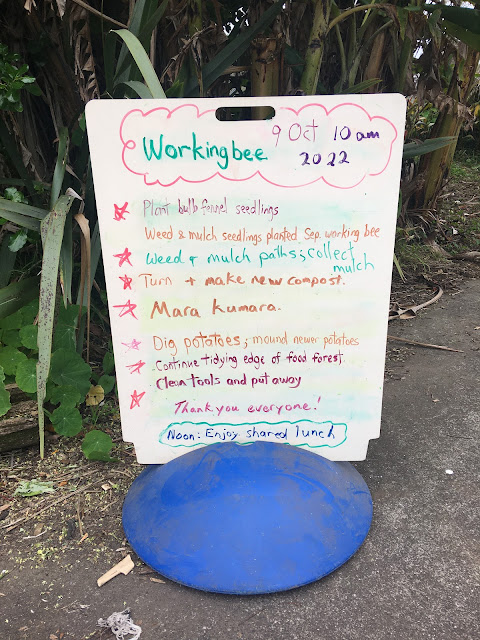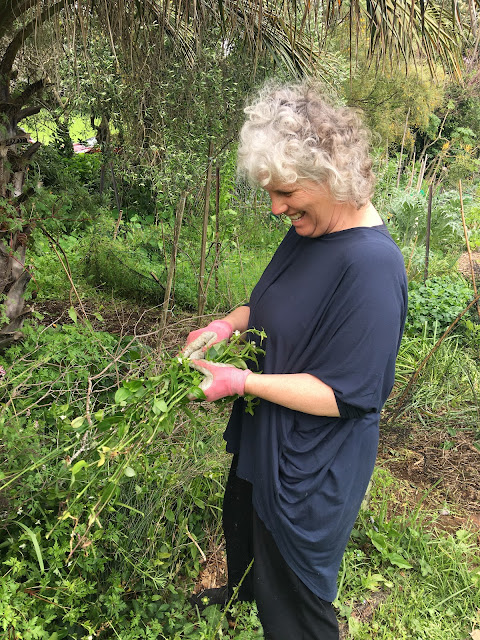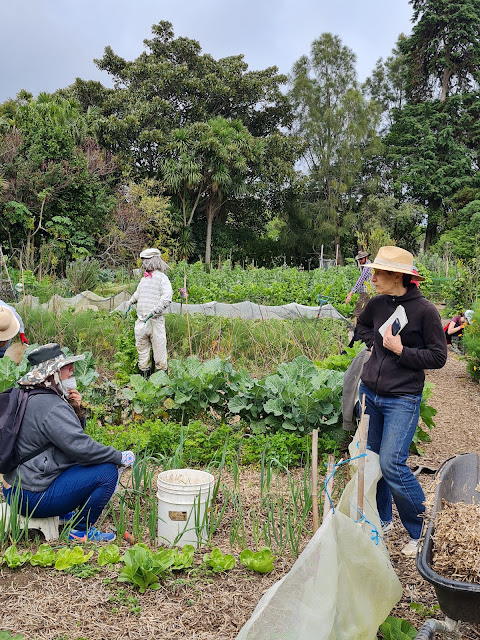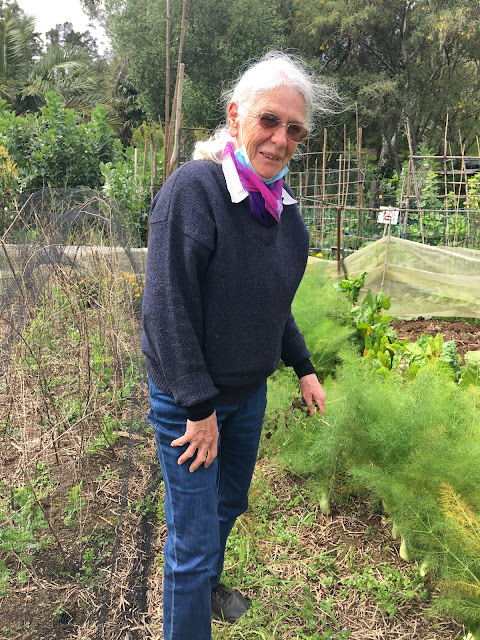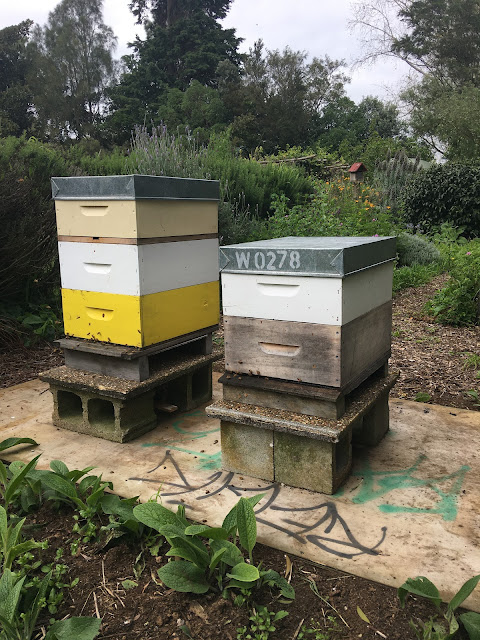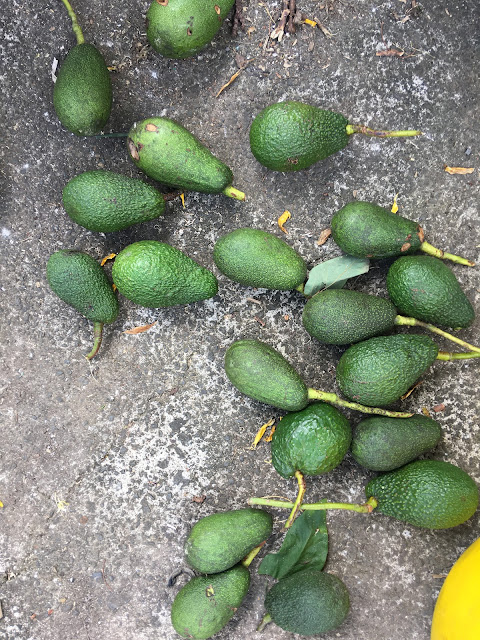Māra Kūmara Special Working Bee November 20th, 2022.
Sunday, 9 October 2022
9 October Working Bee at the Sanctuary Mahi Whenua
After a long hiatus, the working bee blog is back. It lapsed in August 2020, after I was unable to find anyone to take it over from me. Then came Covid and everything got turned upside down. But now, as we emerge into our new 'normal' the Steering Group has decided to re-establish the blog as a seasonal posting. (If anyone is interested in helping publish the blog more often, please get in touch to give it a go).
And so we begin;
Our regular monthly working bee morning was cloudy but fine - perfect conditions for us all to be working in the gardens.
A list of tasks to choose from greeted us.
Caitlin helped to dig and uplift the first of the new season potatoes.
Caitlin returned home to Aotearoa/NZ last week from a trip back to Ireland, and as a busy dance teacher for young children, we were delighted that she had the energy to come along to today's working bee.

Anna and Asher (2 years young), also helped with the potato harvest with Asher doing great work putting them into the bucket.
At the same time, Simon (not photographed - sorry Simon) was mulching paths. Then Anna, Asher, and Simon moved the empty tank by the shed to allow the shed exterior to be cleaned by the water blaster.
The engine of the gardens is our compost and the bins are breaking down
our organic waste nicely.
Steve turned the compost.
Steve is also supplying the Steering group with information and costings for the upgrading of the compost bins. They have once again become somewhat dilapidated.
Steve's trusty companion, Rusty - aged 14 years young, came along too.
This is to protect the native seedlings that we have planted where the bamboo was removed. Turning vehicles have been damaging the young plants so it has now been fenced off to provide them with some protection.
The Warratahs (that were donated) and a long run of orange mesh fencing.
Hopefully, the young native seedlings will now be able to grow and thrive without being squashed or backed over by vehicles.

Our precious native seedlings.
Helen, the Hugelkulur continues to grow and decay nicely in the food forest. Here's an old blog that's all about how we built her in a workshop with Ellen Schindler;
https://www.blogger.com/blog/post/edit/8589877769323331195/7432340628080077898?hl=en
The beautiful pathway into the SMW from Oakley Creek.
Liam (plot-holder Matthew's flatmate) came by to help out.
Carla weeded and mulched the beetroot and Kohl Rabi and...
...her daughter Caitlin came along to lend a hand too.
Sarah is a Community member although not a plot holder.
She regularly contributes to our working bees. Thank you Sarah.
Nick - Sarah's partner - also helped out with the potatoes. Thank you Nick.
Rosie weeded and tidied pocket gardens on the DNA path.
Rebekah weeded out the invasive weeds near the front of the gardens.
Tina, from Iran, weeded the Leeks.
Another non-plot-holding community member.
Welcome Tina, haere mai.
Jen (your blog author) chatting with Tina.
Rose weeded the fennel.
The beehives are doing well on their new site.
Thanks to Walter for looking after them.
Clement repaired the greenhouse - brilliant.
Our very own carpenter. Merci Clement.
One of the roof repairs - tricky work to access!
Clement, John, and Bev (obscured) review the greenhouse.
Bev and John assess the seedlings in the greenhouse - all are currently being hand watered. Once our new solar pump is installed in the greenhouse, the irrigation will once again be fully functional and will save hours of hand-watering time - Huzzah!
Our Kumara tipu are being grown by Trevor from the kumara we harvested last season: the red ones were originally from Lionel Hotene, Papatūānuku Kōkiri Marae, and the white ones from Xanthe White. In mid-October, there may be additional heritage kumara slips available and hopefully, we will have the capacity (space) to grow some of them.
Trevor back from the Grey Lynn Farmers Market.
Rose's sister Dot came along too - here talking with Bev.
Sarah washing up with Rebekah in the background.
And then it was lunchtime and we enjoyed a delicious shared lunch together.
Shared produce for today's working bee participants included our Swift potatoes.
Kusaie Limes
Avocadoes
Greens
And some delicious herbs and flowers.
Chris Casey also called by to update us on the bid to save all of Building One - the heritage brick building on Carrington Road. Chris is a great defender of and advocate for the SMW gardens and helped us save the gardens from the initial development plans that would have seen the demise of the gardens 5 years ago.
See their Facebook page here

and the petition link here
and the Point Chevalier Enterprise Trust https://www.pcset.org.nz/
The Mulberry bush behind Chris was planted at the SMW celebration when our eviction notice was rescinded 5 years ago. It's growing well.

In other SMW news
- The Steering Group has not received any additional information regarding the Swale trees. Trevor continues to chase this up.
- Roadworks are scheduled to begin soon (October - April). There will be new footpaths, cycleways, and road. Little information has been forthcoming but we are hopeful we will be updated soon...
- We are still unclear on what will happen to the spring water currently flowing through the channel. We have been liaising with Wendy John from Friends of Oakley Creek, to review the original plans to try to determine the source of the spring.
- On the morning of Tuesday 11th October, the shed will be water blasted to clean and tidy it up. This is part of our 'best-foot-forward' strategy. Rather than waiting to see what will happen with the SMW, the Steering Group has decided to enable the SMW to flourish and grow. The wider community will once again see what a wonderful and precious asset the SMW gardens and environs are for everyone.
- All water tanks are full of water. Thanks once again to Clement for repairing all of the gutters to capture the water from our sheds.
- When unlocking the padlocks on the water taps - ensure the code numbers are aligned with the black lines BEFORE re-locking them, please. Otherwise, the combination may inadvertently be changed and access lost until reset - Yikes!
- The next working bee is November 13th. See you all there then, if not before.
Until then, Happy Gardening Everyone.
Tuesday, 11 August 2020
Almost Spring Workshop by John
At our regular monthly working bee on Sunday 9th August, we were pleased to have a workshop by John on how to plant seeds and seedlings.
August is the beginning of Spring, with the Grey Warblers singing being a good sign.
September is a better time to plant seeds that need more warmth.
Now (August) plant;
Brassicas - Chinese cabbage, Bok Choy, spring onions, spring onions, radish, turnips, peas, parsley, etc.
September;
Pumpkin, beans - scarlet runners then climbers and dwarf.
Always kale and silverbeet.
Later eggplant, capsicums, etc that need more heat.
Refer to the seed catalogues for planting seasonal ideas - there is lots of information there.
If seedlings growing time is more than 2-3 weeks then you will need to add additional nutrients to the potting mix - Biofert, lime and, pumice sand.
If soil is too acid or alkaline it locks up nutrients.
Acid - add lime but very cautiously!
Trays
Hygienic, rigid and strong
Bigger individual seeds eg - peas or beans, can be planted into the round singles trays.
Fill the tray and level the potting medium
Next compress
Divide the tray with sticks and plant each variety of seed in their own 'lane'.
Label seeds - what, when, and your name.
NB Please use a pencil to label your seeds.
Then sift a top layer of potting mix over the seeds until they are 'just covered'. Lettuce needs light to germinate so don’t cover too deeply. Now is a good time for lettuce as it likes cool temperatures to germinate.
Then give a good soak of water... gently.
Greenhouse irrigation has been upgraded and is available to grow seedlings for your plot - please ensure you have enough space in your plot for your seedlings!
Cover with a board/corflute or card to keep moist for a day or two until you see some germination (1-2 days) and then remove the cover to allow the light onto the seedlings.
Sow things from the same family or small seeds so they’re compatible.
For peas or beans use individual cell trays. Peas and beans are good to plant now.
Root vegetables do not like root disturbance so plant these in cell trays to minimise root disturbance. Individual pots are better than cells.
Pricking out is done to grow plants on to a bigger size before planting out if this is needed.
Also replanting into cells refreshes the soil thereby making more nutrients available to the seedlings.
Fill and level cells
(Dimple with your fingers to centre seeds - if you are planting seeds).
Otherwise, uplift seedlings with some soil left on the root. Lift with leaves NOT the stem as this may crush them.
Firm in the roots.
If roots are too big - make a bigger hole.
Use bamboo tweezers to lift from the leaves.
Label.
Water in.
To remove seedlings when ready to plant - use a pegboard to pop them out or use an individual stick and push the seedlings out from underneath.
Minimise roots disturbance.
Spring - September is big push time for seedlings
Prepare beds.
Dig in green crops.
Dig over beds and add compost.
Beds need feeding with compost, organic matter- lupins, etc.
also, add Biofert (also has trace elements) to the beds - also possibly lime after test pH.
'Blood and Bone' is useful but also add potash.
Do not use Horse manure as it is often full of weed seeds. Commercial sheep pellets are okay.
Liquid fertiliser is difficult as it's hard to know if it is organic or not.
Compost - 2 buckets per season per plot - Summer and winter. It takes a lot of vegetation and communal work to produce these bucketfuls.
Compost must be dug in and not used as mulch. Spread the compost on to the surface and then dig into the first few inches before planting out seedlings.
Plant root veg directly into the soil and protect from the birds.
Seagrass mulch will deter the birds - as will netting. Then thin out as the young plants come up.
Psyllid insect has now invaded NZ. It affects potatoes and tomatoes. Psyllid transmit a bacterium and ruin the crop. So cover the crop with fine white mesh/netting cloth. Plant early to help avoid Psyllid.
Liseta potatoes for Xmas. Maori potatoes do not seem to be so affected by Psyllid.
Please return and clean your trays and used labels so they are recycled for other members to reuse. It's also a good idea to keep a notebook of what and when you sowed and keep growing notes.
Recommended reading;
Prof Walker booklet
Also,
And
Happy Gardening everyone.
Subscribe to:
Comments (Atom)

